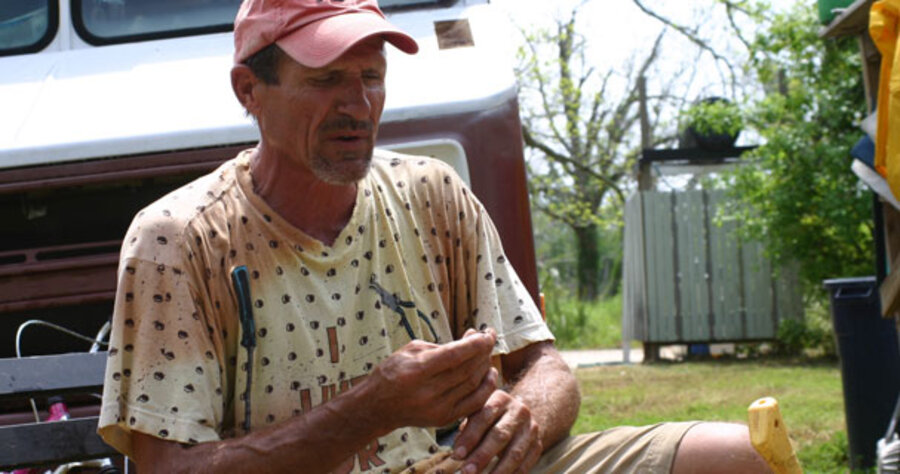Recovery's worker bees bring different flavor to Gulf Coast
Loading...
| Bay St. Louis, Miss.
Driving an old bread van, Gary Schmalz, a metalworker from Greensboro, S.C., left for Mississippi a year ago with his dog, Booger. The scruffy duo is part of a population backwash that is reversing the massive post-Katrina exodus from the Gulf Coast – the old guard and fortune-seekers alike seeking a patch of peace, a job, and a new life in the sun.
Mr. Schmalz is one of 6,000 people who moved in the past year here to Hancock County, which took the brunt of hurricane Katrina on Aug. 29, 2005, and lost half its residents in the subsequent exodus. That makes it the fastest-growing county in Mississippi, part of a boom that's changing the makeup of the Gulf Coast.
Katrina in many ways became a great equalizer, imposing losses on the rich and distributing billions in federal rebuilding aid to the blue-collar workers who flowed into the region to repair the destruction. In all, the storm killed 234 Mississippians and destroyed 14,449 homes, apartment buildings, and businesses along the Mississippi coast.
The result is a decided change of character in places like Bay St. Louis, the Hancock County seat. Old-money, beach-front mansions on bluffs overlooking the Gulf are gone, along with the Picassos and Rembrandts inside. Newly apparent are the displays of wealth of the newcomers: monster trucks and jet skis.
"What happens in the wake of a natural disaster is that different people come into play, where you get a nouveau riche phenomenon and older money moving out," says Stephen Horwitz, an economist at St. Lawrence University in Canton, N.Y.
Construction of yacht marinas, neon-lit casinos, houses, and condos is fueling a new moneyed Mississippi class. Families from states like California and investors from Baton Rouge, La., are taking advantage of $5 billion in federal tax credits to invest in water-logged historic structures in places like Gulfport and Ocean Springs. Meanwhile, poorer residents who didn't have insurance before the storm are struggling for purchase on the coast, making up the largest numbers of those who have moved elsewhere or are still stuck in trailers.
Over in Harrison County, home to Gulfport, census figures show a big jump in the number of Hispanic residents and a $10,000 leap in the median household income from 2000 to 2007. Wages grew by a higher than expected 3.77 percent in 2007 over 2006. Unemployment continues to fall, from a poststorm rate of 9.5 percent to 6.1 percent today.
Indeed, Mississippi as a whole is experiencing net in-migration for the first time since the casino boom of the mid-1990s, says Barbara Logue, a state demographer. Yet it's unknown, she says, whether the newcomers will stay after the rebuilding tapers off.
That's Schmalz's dilemma. He lives in an air-conditioned rented trailer and has made himself at home, as can be seen by tomato plants in pickle barrels hanging from a nearby tree. Work isn't as plentiful as he'd like, so he spends part of his days cruising around the city picking up nails with a wheeled magnet that's attached to his bicycle – his version of community service.
"It's hard to think of a nicer place to be," he says. "I may well stick around."





